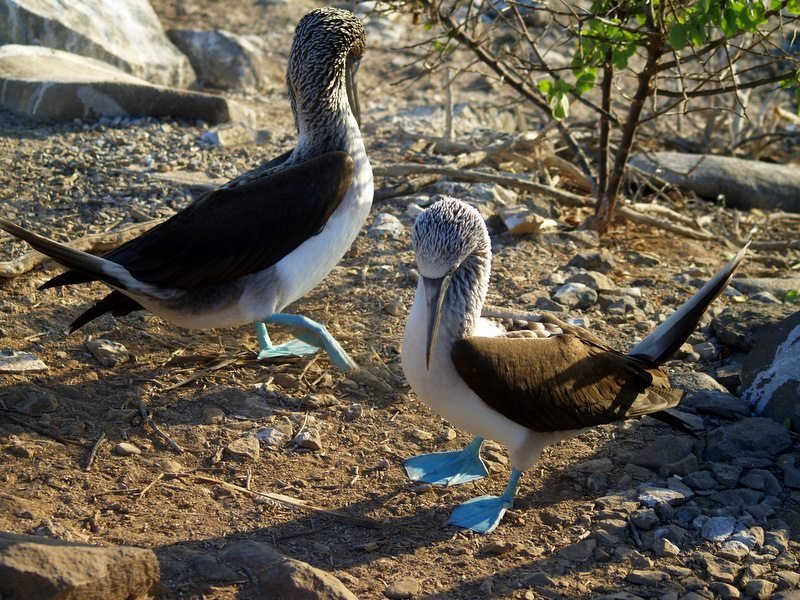Cruising the Galapagos Islands: Trip of a Lifetime Stuff
 I look down to see if I am still on the trail and a heron stands just behind me, his head cocked to point an eye at me. Unimpressed, he returns to considering the path and the line of people on it watching a cormorant’s nest opposite him. With a couple more little jerks of his head, he makes a decision and walks right between me and another traveler, very nearly stepping on my foot.
I look down to see if I am still on the trail and a heron stands just behind me, his head cocked to point an eye at me. Unimpressed, he returns to considering the path and the line of people on it watching a cormorant’s nest opposite him. With a couple more little jerks of his head, he makes a decision and walks right between me and another traveler, very nearly stepping on my foot.
Clearly he doesn’t need to mind where he is going. I, however, have strict instructions not to step off the path, which is just unaltered terrain between a few scattered posts along the coast.
“The policy of the Galapagos National Park is to leave everything as natural as possible,” says my guide. There are no docks, pit toilets, garbage receptacles or park offices out here. With the exception of an occasional trail post, the island looks completely untouched. But that is an illusion; though 97% of the land area and most of its waters are protected, the islands are constantly under threat from the world outside. Its history of geographical isolation is trumped by human population growth, introduced species, and illegal fishing and poaching. This trip of a lifetime could potentially be the trip of my lifetime.
See the video of my Galapagos trip
The Galapagos Archipelago, made up of 14 islands and over 120 islets and rocks, straddles the equator 612 miles off the coast of Ecuador. Volcanoes formed the islands three to four million years ago, and though conditions are often quite harsh—many of the islands are mostly rock with scraggly plant life and no fresh water—life has adapted and flourished in isolation from the rest of the world. 40% of the roughly 5,000 plant and animal species here are unique.
 I am traveling aboard the 40-person yacht Isabela II. Typically, I cringe at the thought of a cruise, but be assured that time aboard an expedition cruise is not conga lines and lounge acts. Wakeup call is at 6 a.m. for shore excursions as we sail on our meandering path through the archipelago. Daily activities invariably include some hiking, and often add snorkeling, swimming, kayaking or glass-bottomed boat tours. At the end of the day, there are presentations on evolution, plants and animals, geology, and Charles Darwin. My fellow travelers come from all over the world and range from 20-something couples to 70-year old-retirees, all with the same goal of seeing a rare world.
I am traveling aboard the 40-person yacht Isabela II. Typically, I cringe at the thought of a cruise, but be assured that time aboard an expedition cruise is not conga lines and lounge acts. Wakeup call is at 6 a.m. for shore excursions as we sail on our meandering path through the archipelago. Daily activities invariably include some hiking, and often add snorkeling, swimming, kayaking or glass-bottomed boat tours. At the end of the day, there are presentations on evolution, plants and animals, geology, and Charles Darwin. My fellow travelers come from all over the world and range from 20-something couples to 70-year old-retirees, all with the same goal of seeing a rare world.
My group arrives at Hood Island in a rubber launch called a panga and we slip over the sides into knee-deep water—a wet landing. I am completely out of place here. As I ogle the so-called wild animals, they ogle me. What on earth are these upright beasts doing on this island, so ill-adapted to the strong sun, hopelessly vulnerable to the dearth of fresh water and food? Only the crabs seem to be cautious, scuttling away when I am finally within a quick grab of their orange and blue armor glinting in the sun.
 Maybe they’re the smart ones. The human population in the islands is estimated at over 30,000, many of whom are there illegally. Over 120,000 tourists came in 2006 and the authorities may set a lower limit as concern grows about the negative impact of so many people.
Maybe they’re the smart ones. The human population in the islands is estimated at over 30,000, many of whom are there illegally. Over 120,000 tourists came in 2006 and the authorities may set a lower limit as concern grows about the negative impact of so many people.
We are warned not to touch any of the animals, but the animals have no rules about that. Finches land on shoulders. Sea lions flop across the sand to come sniff out what we are all about. Perhaps their mothers should have warned: if I touch an infant, my scent could be a death sentence. Mothers recognize their offspring by smell. (No wonder—just try to visually pick one sea lion out of a lineup of 100.) A pup wanders the beach wailing in distress while its mother is probably out searching for food. We spend just over an hour at this location but only one female comes over and—as if demonstrating what the naturalist has just told us—brushes along the pup’s fur with her nose. Then she continues on down the beach leaving the pup to wail some more. The humans look on hoping that what will probably happen, won’t. Here and there throughout our hikes I have seen the tiny carcasses like macabre deflated balloons shriveled up and dried in the harsh sun.

“Doesn’t the park save the animals?” someone asks.
The answer is no. Sometimes, as with a healthy sea lion population, our human commitment to preservation requires inaction; other times, as in the case of the giant tortoise, it requires an effort to reverse past abuses.
We spend an afternoon at the Charles Darwin Research Station (CDRS) which operates a tortoise farm on Santa Cruz island. There were once fifteen subspecies of land tortoises in the Galapagos Islands and four of those are now lost. The lumbering reptiles were easily hunted for food and their shells, and even the scientists themselves once wanted them in museums. Part of the CDRS’s work is the eradication of invasive species. Goats and rats are just a couple of continuing threats to the native animal population.
The celebrity of the CDRS is Lonesome George, the last known example of the Pinta subspecies. That thought sticks in my head: this creature is gone forever one or two generations from now. Recent genetic samples from Isabela Island have given some hope that there may be another Pinta tortoise there, but even so, the odds of survival for this species are abysmal.
A tanker that ran aground off San Cristobal in 2001 showed how much damage can be done in just a moment’s carelessness. Though it was a “minor” spill of diesel—which unlike crude oil evaporates quickly and is less toxic—over 60% of the marine iguanas on nearby Santa Fe were dead within a month. The guide stops to show us this odd reptile that dives for its meals of algae. They have adapted to drink seawater and expel salt from their bodies by sneezing which my naturalist jokingly refers to as “snot rocketing.”
For my last excursion I opt for time in a kayak while most of the rest of the group joins a panga tour of the shoreline along Floreana Island. It is a rare opportunity to explore a bit by myself. I stop paddling and sit still as the motor of the panga becomes a distant hum. I look around me at the small bay, at the volcanic ash cones like perfect mountains beyond, and I listen to wind and wave. Something moves and I glance around at the rocks and I see them all staring right back at me. Sea turtles. My heart leaps and my hand instinctively goes for my camera. But they are nothing more than little heads like periscopes poking through the smooth surface of the sea in a circle around me, curious about that bright yellow boat with the odd fins. No camera captures the feeling of mutual observation. I raise the paddle and seven rocks disappear from the bay.
Moments later I find a playful sea lion. She’s nosing along the shallows in search of food and I dip my waterproof camera into the water to try to get a shot of her blowing bubbles into the lens. She glides into a smaller inlet that will soon become cut off from the sea as the tide slips from the sands and the sharp rocks rise up around it like fortifications. I rush to see before it’s too late.
See the video of my Galapagos trip
_______________________________________________________________
 If You Go – The Galapagos Islands
If You Go – The Galapagos Islands
What you see depends on when you go. Blue-footed boobies begin courting in May, sea lions start giving birth in August, and giant tortoise eggs begin hatching in December. April and May offer good visibility for snorkelers and the best weather. And the Galapagos penguins are most active from May through September. High seasons (and higher prices) are June 15 to September 14 and November 1 to April 30.
Prices start around $500USD for 4-day non-luxury tours, but I recommend 7 days minimum. (Half of a four-day trip is arrival and departure and just settling in.) The national park fee is not typically included in the price and is $100USD payable in cash on arrival.
My trip was with Avalon Waterways and Metropolitan Touring. Avalon offers 9- and 14-day trips which include some ground touring in Ecuador, starting at USD$2,239 excluding airfare.
Arrivals are by air from Guayaquil (or Quito via Guayaquil) and most cruises depart from Baltras Island. Aerogal and TAME offer flights to the islands.



 ORDER YOUR COPY TODAY!
ORDER YOUR COPY TODAY! ORDER YOUR COPY TODAY!
ORDER YOUR COPY TODAY!
Pingback: When Animals Attack! Kenya Edition
Pingback: The Mad Traveler in the Galapagos Islands (Video)
Pingback: Photo of the Week: Tree Frog in Ecuadorian Amazon
Pingback: Galapagos Loses an Honored Resident: RIP Lonesome George
Lovely write up on your trip to the Galapagos. My husband and I recently returned from a visit to the Darwin-famous isles and stayed aboard a small passenger catamaran for 5 nights. The experience was memorable, to say the least. I’d definitely recommend a smaller vessel vs. a large boat for people that don’t have issues with sea sickness anyway. 🙂
You can read about our experience here >> http://wp.me/p3UGiL-1oi